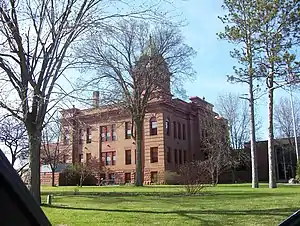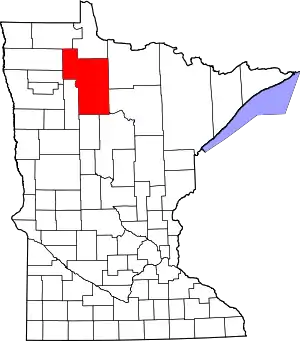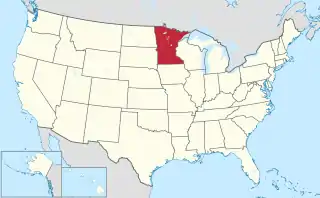Beltrami County, Minnesota
Beltrami County (/bɛlˈtræmiː/ bel-TRAM-ee) is a county in the northern part of the U.S. state of Minnesota. As of the 2010 United States Census, the population was 44,442.[2] Its county seat is Bemidji.[3] The county's name comes from Italian adventurer Giacomo Beltrami from Bergamo, who explored the area in 1825. The county was created in 1866 and organized in 1896.[4]
Beltrami County | |
|---|---|
 Beltrami County Courthouse | |
 Location within the U.S. state of Minnesota | |
 Minnesota's location within the U.S. | |
| Coordinates: 48°01′N 94°55′W | |
| Country | |
| State | |
| Founded | February 28, 1866 (created) 1896 (organized)[1] |
| Named for | Giacomo Constantino Beltrami |
| Seat | Bemidji |
| Largest city | Bemidji |
| Area | |
| • Total | 3,056 sq mi (7,920 km2) |
| • Land | 2,505 sq mi (6,490 km2) |
| • Water | 551 sq mi (1,430 km2) 18%% |
| Population (2010) | |
| • Total | 44,442 |
| • Estimate (2019) | 47,188 |
| • Density | 18.6/sq mi (7.2/km2) |
| Time zone | UTC−6 (Central) |
| • Summer (DST) | UTC−5 (CDT) |
| Congressional districts | 7th, 8th |
| Website | www |
Beltrami County comprises the Bemidji, MN Micropolitan Statistical Area.
Portions of the Leech Lake and Red Lake Indian reservations are in the county. The northernmost portion of the Mississippi River flows through the southern part of the county, through Bemidji. Beltrami, Renville, and Stearns are Minnesota's only counties that abut nine other counties.
Geography
Beltrami County's southwest corner is considered part of the headwaters of the Mississippi River, which flows easterly and northeasterly from Lake Itasca through the southern part of the county. Much of the middle and upper county is taken up with the two sections of Red Lake. The county terrain consists of rolling low tree-covered hills, dotted with lakes and ponds.[5] The terrain slopes to the east and north. Its highest point is a small hill 1.3 mile (2.1 km) northwest of Wolf Lake, at 1,511' (460m) ASL;[6] otherwise the terrain high point is near its southwest corner, at 1,457' (444m) ASL.[7] The county has a total area of 3,056 square miles (7,920 km2), of which 2,505 square miles (6,490 km2) is land and 551 square miles (1,430 km2) (18%) is water.[8] It is the fourth-largest county in Minnesota by area.
Major highways
Adjacent counties
- Lake of the Woods County - north
- Koochiching County - northeast
- Itasca County - east
- Cass County - southeast
- Hubbard County - south
- Clearwater County - southwest
- Pennington County - west
- Marshall County - west
- Roseau County - northwest
Protected areas[5]
- Bagley Lake State Wildlife Management Area (part)
- Buena Vista State Forest
- Chippewa National Forest (part)
- Lake Bemidji State Park
- Long Lake State Wildlife Management Area
- Mississippi Headwaters State Forest (part)
- Pine Island State Forest (part)
- Red Lake Peatland Scientific and Natural Area (part)
- Three Island Lake County Park
Climate and weather
| Bemidji, Minnesota | ||||||||||||||||||||||||||||||||||||||||||||||||||||||||||||
|---|---|---|---|---|---|---|---|---|---|---|---|---|---|---|---|---|---|---|---|---|---|---|---|---|---|---|---|---|---|---|---|---|---|---|---|---|---|---|---|---|---|---|---|---|---|---|---|---|---|---|---|---|---|---|---|---|---|---|---|---|
| Climate chart (explanation) | ||||||||||||||||||||||||||||||||||||||||||||||||||||||||||||
| ||||||||||||||||||||||||||||||||||||||||||||||||||||||||||||
| ||||||||||||||||||||||||||||||||||||||||||||||||||||||||||||
In recent years, average temperatures in the county seat of Bemidji have ranged from a low of −4 °F (−20 °C) in January to a high of 79 °F (26 °C) in July, although a record low of −50 °F (−46 °C) was recorded in January 1950 and a record high of 101 °F (38 °C) was recorded in July 1975. Average monthly precipitation ranged from 0.59 inches (15 mm) in February to 4.33 inches (110 mm) in July.[9]
Demographics
| Historical population | |||
|---|---|---|---|
| Census | Pop. | %± | |
| 1870 | 80 | — | |
| 1880 | 10 | −87.5% | |
| 1890 | 312 | 3,020.0% | |
| 1900 | 11,030 | 3,435.3% | |
| 1910 | 19,337 | 75.3% | |
| 1920 | 27,079 | 40.0% | |
| 1930 | 20,707 | −23.5% | |
| 1940 | 26,107 | 26.1% | |
| 1950 | 24,962 | −4.4% | |
| 1960 | 23,425 | −6.2% | |
| 1970 | 26,373 | 12.6% | |
| 1980 | 30,982 | 17.5% | |
| 1990 | 34,384 | 11.0% | |
| 2000 | 39,650 | 15.3% | |
| 2010 | 44,442 | 12.1% | |
| 2019 (est.) | 47,188 | [10] | 6.2% |
| US Decennial Census[11] 1790-1960[12] 1900-1990[13] 1990-2000[14] 2010-2019[2] | |||

As of the 2000 United States Census, there were 39,650 people, 14,337 households, and 9,749 families in the county. The population density was 15.8/sqmi (6.11/km2). There were 16,989 housing units at an average density of 6.78/sqmi (2.62/km2). The racial makeup of the county was 76.66% White, 0.36% Black or African American, 20.36% Native American, 0.57% Asian, 0.02% Pacific Islander, 0.21% from other races, and 1.84% from two or more races. 0.99% of the population were Hispanic or Latino of any race. 21.6% were of German, 19.7% Norwegian and 5.6% Swedish ancestry. 95.1% spoke English and 2.4% Ojibwa as their first language.
There were 14,337 households, out of which 34.60% had children under the age of 18 living with them, 49.30% were married couples living together, 13.60% had a female householder with no husband present, and 32.00% were non-families. 24.80% of all households were made up of individuals, and 9.50% had someone living alone who was 65 years of age or older. The average household size was 2.63 and the average family size was 3.13.
The county population contained 28.70% under the age of 18, 13.90% from 18 to 24, 25.20% from 25 to 44, 20.50% from 45 to 64, and 11.70% who were 65 years of age or older. The median age was 32 years. For every 100 females there were 97.30 males. For every 100 females age 18 and over, there were 93.50 males.
The median income for a household in the county was $33,392, and the median income for a family was $40,345. Males had a median income of $30,434 versus $22,045 for females. The per capita income for the county was $15,497. About 12.90% of families and 17.60% of the population were below the poverty line, including 21.70% of those under age 18 and 12.20% of those age 65 or over.
Over half the children in the county are born out of wedlock. About a third are born to teenaged mothers. The county has about twice the state average in terms of high school dropouts.[15]
Crime
Between 1990 and 2005, the county had a suicide rate four times higher than the state.[16] The county exceeds the state and national rates in both violent and property crimes.[17]
Communities
Townships
- Alaska Township
- Battle Township
- Bemidji Township
- Benville Township
- Birch Township
- Buzzle Township
- Cormant Township
- Durand Township
- Eckles Township
- Frohn Township
- Grant Valley Township
- Hagali Township
- Hamre Township
- Hines Township
- Hornet Township
- Jones Township
- Kelliher Township
- Lammers Township
- Langor Township
- Lee Township
- Liberty Township
- Maple Ridge Township
- Minnie Township
- Moose Lake Township
- Nebish Township
- Northern Township
- O'Brien Township
- Port Hope Township
- Quiring Township
- Roosevelt Township
- Shooks Township
- Shotley Township
- Spruce Grove Township
- Steenerson Township
- Sugar Bush Township
- Summit Township
- Taylor Township
- Ten Lake Township
- Turtle Lake Township
- Turtle River Township
- Waskish Township
- Woodrow Township
Unorganized territories
Census-designated places
Government and politics
From the New Deal realignment in 1932 through 1996, Beltrami County leaned Democratic, selecting the Democratic nominee in every presidential election save Eisenhower's landslides in 1952 and 1956 and Nixon's in 1972. In 2000, George W. Bush became the first Republican to carry the county since 1972. Bush fell short of a majority, with third parties (particularly Green nominee Ralph Nader) doing well statewide, but his 48.5% vote share was higher than any Republican's from 1964 to 1996 save Nixon in 1972 and Reagan in 1984. Beltrami returned to the Democratic column in the next three elections, but in 2016, Donald Trump became the second Republican since 1972 to carry the county, winning a bare majority; in 2020, he won it again, with a slightly improved majority of 50.4%--the first time the county has voted for Republicans two elections in a row since 1952 and 1956.
| Year | Republican | Democratic | Third parties |
|---|---|---|---|
| 2020 | 50.4% 12,188 | 47.2% 11,426 | 2.4% 575 |
| 2016 | 50.0% 10,783 | 40.3% 8,688 | 9.7% 2,093 |
| 2012 | 43.7% 9,637 | 53.6% 11,818 | 2.7% 596 |
| 2008 | 43.9% 9,762 | 54.1% 12,019 | 2.1% 455 |
| 2004 | 48.5% 10,237 | 50.1% 10,592 | 1.4% 302 |
| 2000 | 48.5% 8,346 | 42.4% 7,301 | 9.1% 1,570 |
| 1996 | 36.6% 5,806 | 50.5% 8,006 | 12.9% 2,036 |
| 1992 | 32.6% 5,204 | 45.1% 7,210 | 22.4% 3,573 |
| 1988 | 46.3% 6,652 | 52.6% 7,566 | 1.1% 162 |
| 1984 | 49.4% 7,414 | 49.9% 7,481 | 0.7% 103 |
| 1980 | 41.7% 6,481 | 47.8% 7,432 | 10.5% 1,624 |
| 1976 | 39.3% 5,214 | 56.8% 7,540 | 4.0% 531 |
| 1972 | 52.2% 5,947 | 45.6% 5,194 | 2.2% 252 |
| 1968 | 40.9% 3,912 | 52.6% 5,034 | 6.5% 619 |
| 1964 | 34.7% 3,184 | 65.1% 5,967 | 0.2% 15 |
| 1960 | 49.0% 4,482 | 50.8% 4,653 | 0.2% 22 |
| 1956 | 51.0% 3,974 | 48.8% 3,807 | 0.2% 16 |
| 1952 | 53.8% 4,817 | 45.7% 4,092 | 0.6% 53 |
| 1948 | 32.6% 3,126 | 62.8% 6,020 | 4.5% 434 |
| 1944 | 32.8% 2,705 | 66.5% 5,490 | 0.7% 61 |
| 1940 | 32.8% 3,511 | 65.7% 7,036 | 1.6% 166 |
| 1936 | 24.4% 2,182 | 72.7% 6,507 | 3.0% 268 |
| 1932 | 32.1% 2,318 | 60.7% 4,386 | 7.2% 518 |
| 1928 | 62.3% 4,062 | 34.1% 2,221 | 3.7% 239 |
| 1924 | 46.2% 2,960 | 5.0% 323 | 48.7% 3,121 |
| 1920 | 61.3% 4,518 | 19.4% 1,427 | 19.4% 1,430 |
| 1916 | 33.0% 1,331 | 47.5% 1,912 | 19.5% 785 |
| 1912 | 16.2% 490 | 26.1% 790 | 57.7% 1,745 |
| 1908 | 63.4% 1,882 | 21.8% 648 | 14.8% 439 |
| 1904 | 82.4% 1,953 | 9.9% 234 | 7.8% 184 |
| 1900 | 62.1% 1,339 | 35.5% 767 | 2.4% 52 |
| 1896 | 48.0% 202 | 50.6% 213 | 1.4% 6 |
| 1892 | 44.9% 57 | 34.7% 44 | 20.5% 26 |
On January 7, 2020, in response to Trump's executive order, the Beltrami County Board of Commissioners voted to prohibit refugees from resettling in the area.[19]
| Position | Name | District | |
|---|---|---|---|
| Commissioner | Craig Gaasvig | District 1 | |
| Commissioner | Reed Olson | District 2 | |
| Commissioner | Richard Anderson | District 3 | |
| Commissioner | Tim Sumner | District 4 | |
| Commissioner and Chairperson | Jim Lucachick | District 5 | |
| Position | Name | Affiliation | District | |
|---|---|---|---|---|
| Senate | Paul Utke[21] | Republican | District 2 | |
| Senate | Justin Eichorn[22] | Republican | District 5 | |
| House of Representatives | Steve Green[23] | Republican | District 2A | |
| House of Representatives | John Persell[24] | Democratic | District 5A | |
| Position | Name | Affiliation | District | |
|---|---|---|---|---|
| House of Representatives | Collin Peterson[25] | Democratic | 7th | |
| House of Representatives | Pete Stauber[26] | Republican | 8th | |
| Senate | Amy Klobuchar[27] | Democratic | N/A | |
| Senate | Tina Smith[28] | Democratic | N/A | |
See also
- Gilfillan Biotic Area
- National Register of Historic Places listings in Beltrami County, Minnesota
- Red Lake, the largest lake that is entirely in Minnesota.
References
- "Minnesota Place Names". Minnesota Historical Society. Archived from the original on October 25, 2014. Retrieved March 17, 2014.
- "State & County QuickFacts". United States Census Bureau. Archived from the original on July 7, 2011. Retrieved August 31, 2013.
- "Find a County". National Association of Counties. Archived from the original on May 31, 2011. Retrieved June 7, 2011.
- Upham, Warren (1920). Minnesota Geographic Names: Their Origin and Historic Significance. Minnesota Historical Society. p. 34.
- Beltrami County MN Google Maps (accessed 4 March 2019)
- Beltrami County High Point, Minnesota. PeakBagger.com (accessed May 4, 2019)
- ""Find an Altitude/Beltrami County MN" Google Maps (accessed 4 March 2019)". Archived from the original on May 21, 2019. Retrieved March 5, 2019.
- "2010 Census Gazetteer Files". US Census Bureau. August 22, 2012. Archived from the original on October 6, 2014. Retrieved October 5, 2014.
- "Monthly Averages for Bemidji MN". The Weather Channel. Retrieved November 6, 2011.
- "Population and Housing Unit Estimates". Retrieved March 26, 2020.
- "US Decennial Census". US Census Bureau. Archived from the original on April 26, 2015. Retrieved October 5, 2014.
- "Historical Census Browser". University of Virginia Library. Retrieved October 5, 2014.
- "Population of Counties by Decennial Census: 1900 to 1990". US Census Bureau. Retrieved October 5, 2014.
- "Census 2000 PHC-T-4. Ranking Tables for Counties: 1990 and 2000" (PDF). US Census Bureau. Retrieved October 5, 2014.
- Dey, Crystal (November 11, 2014). "Beltrami County children continue to struggle: New data shows higher than average poverty compared to state". Bemidii Pioneer. Retrieved June 20, 2018.
- Langman, Peter (January 6, 2009). Why Kids Kill (First ed.). St. Martin's Press. p. 137.
- "Beltrami County, Minnesota". Sperling's Best Places. Retrieved June 20, 2018.
- Leip, David. "Atlas of US Presidential Elections". uselectionatlas.org. Retrieved April 17, 2018.
- "Beltrami Co. becomes first in state to reject refugee resettlement". MPR News. January 7, 2020. Retrieved January 7, 2020.
- "Beltrami County Board of Commissioners". June 24, 2020. Retrieved June 24, 2020.
- "MN State Senate". www.senate.mn. Retrieved June 24, 2020.
- "MN State Senate". www.senate.mn. Retrieved June 25, 2020.
- "Rep. Steve Green (02B) - Minnesota House of Representatives". www.house.leg.state.mn.us. Retrieved June 24, 2020.
- "Rep. John Persell (05A) - Minnesota House of Representatives". www.house.mn. Retrieved June 25, 2020.
- "Congressman Collin Peterson". Congressman Collin Peterson. Archived from the original on June 25, 2020. Retrieved June 24, 2020.
- "Representative Pete Stauber". Representative Pete Stauber. Retrieved June 25, 2020.
- "U.S. Senator Amy Klobuchar". www.klobuchar.senate.gov. Retrieved June 24, 2020.
- "Home". Senator Tina Smith. Retrieved June 24, 2020.
External links
- Official website
- 360 Degree Virtual Tour of 2011 Beltrami County Fair
